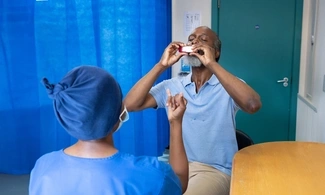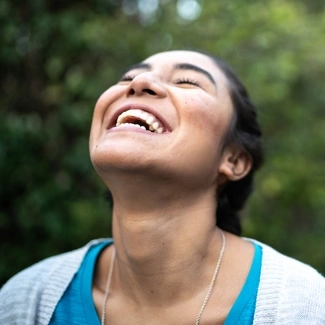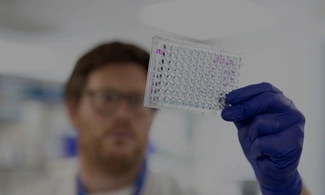Sarcoidosis is a very rare condition in children. We have information for parents and carers about what sarcoidosis in children is, how it’s caused, and how it’s treated and managed.
We also have information on sarcoidosis in adults.
On this page:
- What is sarcoidosis?
- What causes sarcoidosis?
- How common is sarcoidosis in children?
- What are the symptoms?
- How is sarcoidosis diagnosed in children?
- How is sarcoidosis treated in children?
- Outlook for children with sarcoidosis
- More support
What is sarcoidosis?
Sarcoidosis is a very rare condition where collections of tissue form lumps, called granulomas, in organs such as the lungs and skin.
Sarcoidosis can also affect the lymph nodes, which are part of the immune system, causing them to become swollen. Lymph nodes help the body fight infection.
Granulomas in the lungs can stop the lungs from working properly.
Granulomas can also form in any other part of the body, including the skin, heart and nervous system. When this happens, your child may have symptoms in that part of the body.
What causes sarcoidosis?
Because sarcoidosis is so rare, we don’t know exactly what causes it to develop. We know in some children it’s related to how their immune system works.
Researchers think sarcoidosis in children could be caused by the immune system fighting something that’s not a threat. This leads to the formation of granulomas. We don’t know if there’s a particular environmental cause for this. Sometimes an infection could be the trigger.
In some cases, sarcoidosis affects more than one family member. People in the same family may share genes that make their immune systems more likely to respond like this.
How common is sarcoidosis?
Sarcoidosis is very rare in children. It can affect babies and young children, but it’s more likely to be found in older children and adolescents (teenagers).
It’s estimated that up to 1 in 100,000 children have sarcoidosis.
Sarcoidosis is more common in adults. Find out more about adult sarcoidosis.
What are the symptoms of sarcoidosis in children?
Sarcoidosis can affect children in different ways. They may have no symptoms and sarcoidosis might only be found if they have a chest X-ray.
Sarcoidosis affects different parts of the body, so symptoms between children can vary. Your child might experience:
- fever
- tiredness
- weight loss or weight gain
- a dry cough
- breathlessness
- chest pain
- a skin rash
- joint pain
- stomach pain
- eye pain or a red eye.
How is sarcoidosis diagnosed in children?
Sarcoidosis in children can be difficult for doctors to diagnose. This is because it’s rare, and the symptoms are like those of other conditions.
If doctors think your child may have sarcoidosis, they will ask you about your family medical history. Tests for sarcoidosis in children may include:
- a biopsy of the lung or other affected organs to look for granulomas. This is when a surgeon takes a small tissue sample, sometimes using keyhole surgery. It is usually done under local anaesthetic, so your child won’t feel anything
- a chest X-ray or CT scan to look at the lungs and the lymph glands
- a breathing test to test how your child’s lungs are working
- an eye exam to look for signs of inflammation in the eye
- blood tests
- pee (urine) tests.
How is sarcoidosis treated in children?
Not all children with sarcoidosis need treatment, particularly if they have no symptoms. Children with sarcoidosis will be treated by specialists.
The main treatments for sarcoidosis in children are:
- steroid medication – these reduce the inflammation
- anti-inflammatory medication – these can be steroid-free and help to treat inflammation
- painkillers – to help ease pain caused by the inflammation
- immunosuppressive medication – these will suppress the overactivity of the immune system
- physical therapy – to help with keeping active and maintaining muscle and joint usage
- occupational therapy – to help your child maintain everyday activities like washing, dressing, and using a computer.
Outlook for children with sarcoidosis
Sarcoidosis is different for every child. This makes it hard to predict how long it will last. It may get better on its own over a short period of time, or it may last years or all their life. There is currently no cure, but symptoms can usually be managed with medicine.
Most children treated for sarcoidosis get better over time, but some will continue to have symptoms. If your child has stopped taking steroid medication, their symptoms can sometimes come back. In this case, they will need to restart treatment.
It’s important to help your child take part in their usual activities to help improve their quality of life. Speak to your child’s physical therapist about what exercise they can safely do.
Ask your child’s doctors who to contact if you have any questions, or if you’re unsure about something. It’s important to be able to recognise if your child’s condition is getting worse, or if they’re becoming ill, and when you should seek emergency care. Agree a plan with your child’s specialist about what you should do.
More support
Looking after a child with a long-term condition, like sarcoidosis, can be difficult. It’s important you take time to take care of yourself, as well as your child. Talk to your doctor or nurse if you feel like you’re struggling to cope. You can also always call our helpline – they can help answer your questions or worries. Call 0300 222 5800, Monday to Friday between 9am – 5pm (excluding bank holidays).
You may also want to join our Parent and Carer Support Network which provides support and a space for parents and carers of children with lung conditions to come together.








